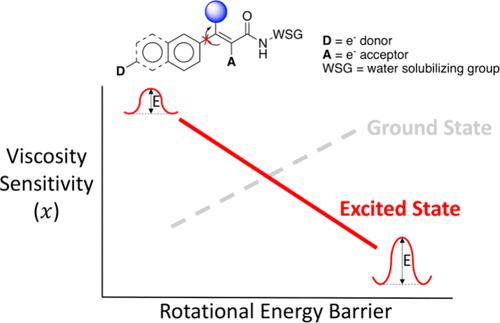当前位置:
X-MOL 学术
›
J. Phys. Chem. B
›
论文详情
Our official English website, www.x-mol.net, welcomes your feedback! (Note: you will need to create a separate account there.)
Excited State Rotational Freedom Impacts Viscosity Sensitivity in Arylcyanoamide Fluorescent Molecular Rotor Dyes
The Journal of Physical Chemistry B ( IF 3.3 ) Pub Date : 2024-04-16 , DOI: 10.1021/acs.jpcb.4c00033 Rachel S. Ehrlich 1 , Saswata Dasgupta 1 , R. Erin Jessup 1 , Kristine L. Teppang 1 , Alexander L. Shiao 1 , Kun Yong Jeoung 1 , Xuanmin Su 1 , Aashish Shivkumar 1 , Emmanuel A. Theodorakis 1 , Francesco Paesani 1 , Jerry Yang 1
The Journal of Physical Chemistry B ( IF 3.3 ) Pub Date : 2024-04-16 , DOI: 10.1021/acs.jpcb.4c00033 Rachel S. Ehrlich 1 , Saswata Dasgupta 1 , R. Erin Jessup 1 , Kristine L. Teppang 1 , Alexander L. Shiao 1 , Kun Yong Jeoung 1 , Xuanmin Su 1 , Aashish Shivkumar 1 , Emmanuel A. Theodorakis 1 , Francesco Paesani 1 , Jerry Yang 1
Affiliation

|
The microviscosity of intracellular environments plays an important role in monitoring cellular function. Thus, the capability of detecting changes in viscosity can be utilized for the detection of different disease states. Viscosity-sensitive fluorescent molecular rotors are potentially excellent probes for these applications; however, the predictable relationships between chemical structural features and viscosity sensitivity are poorly understood. Here, we investigate a set of arylcyanoamide-based fluorescent probes and the effect of small aliphatic substituents on their viscosity sensitivity. We found that the location of the substituents and the type of π-network of the fluorophore can significantly affect the viscosity sensitivity of these fluorophores. Computational analysis supported the notion that the excited state rotational energy barrier plays a dominant role in the relative viscosity sensitivity of these fluorophores. These findings provide valuable insight into the design of molecular rotor-based fluorophores for viscosity measurement.
中文翻译:

激发态旋转自由度影响芳基氰酰胺荧光分子转子染料的粘度灵敏度
细胞内环境的微粘度在监测细胞功能中起着重要作用。因此,检测粘度变化的能力可用于检测不同的疾病状态。粘度敏感的荧光分子转子是这些应用的潜在优秀探针;然而,人们对化学结构特征和粘度敏感性之间的可预测关系知之甚少。在这里,我们研究了一组基于芳基氰酰胺的荧光探针以及小的脂肪族取代基对其粘度敏感性的影响。我们发现取代基的位置和荧光团的π网络类型可以显着影响这些荧光团的粘度灵敏度。计算分析支持这样的观点:激发态旋转能垒在这些荧光团的相对粘度灵敏度中起主导作用。这些发现为用于粘度测量的基于分子转子的荧光团的设计提供了宝贵的见解。
更新日期:2024-04-16
中文翻译:

激发态旋转自由度影响芳基氰酰胺荧光分子转子染料的粘度灵敏度
细胞内环境的微粘度在监测细胞功能中起着重要作用。因此,检测粘度变化的能力可用于检测不同的疾病状态。粘度敏感的荧光分子转子是这些应用的潜在优秀探针;然而,人们对化学结构特征和粘度敏感性之间的可预测关系知之甚少。在这里,我们研究了一组基于芳基氰酰胺的荧光探针以及小的脂肪族取代基对其粘度敏感性的影响。我们发现取代基的位置和荧光团的π网络类型可以显着影响这些荧光团的粘度灵敏度。计算分析支持这样的观点:激发态旋转能垒在这些荧光团的相对粘度灵敏度中起主导作用。这些发现为用于粘度测量的基于分子转子的荧光团的设计提供了宝贵的见解。



























 京公网安备 11010802027423号
京公网安备 11010802027423号